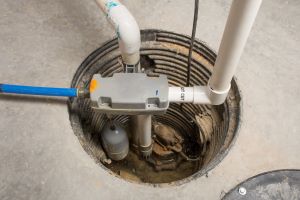
Water is vital for all living things. Yet, it can be too much of a good thing when it comes to summer storms. Summer showers and severe storms can lead to wet basements, especially if the ground is dry from drought conditions or saturated after heavy rain events.
Maintaining your exterior drain lines and interior sump pump(s) are crucial ways to protect your basement from potential water damage that could impact your mechanical systems and belongings. Paying particular attention to exterior drain lines and sump pump(s) will also help preserve the structural integrity of your foundation.
Here are seven things to consider when evaluating your line of defense against water in your basement:
- Keep exterior drains lines clear: Engage a licensed plumber or contractor to perform preventative maintenance on exterior drain lines. Set a maintenance schedule according to their recommendations. If your region enjoys a milder than usual winter, bump up that schedule. Milder winters can mean shorter time for trees to go dormant, thus extending the opportunity for tree roots to grow and potentially clog exterior drain lines.
- Sump pumps have a shelf life: The average life expectancy of sump pumps is ten years. A licensed plumber should be able to confirm the age and condition. Be sure to replace your sump pump(s) before proper operation becomes an issue.
- Newly purchased home: If a home is new to you, make it a priority to have the condition of your exterior drain lines and sump pump evaluated. In my experience, sump pump condition can be easily overlooked as new owners become acquainted with maintenance needs.
- Self-Test and visually inspect your sump pump(s). Self-test and visually inspect the condition of your sump pump(s) twice a year, ideally before the spring and fall seasons. Learn what to check here.
- Auxiliary power source: Storm systems can bring about both heavy rains and power outages. A back-up power supply helps ensure that your sump pump can perform for you when you need it most. Look for capacity of 8-12 hours, or more.
- Keep crock clean: A cover over your sump crock keeps basement debris (and small pets!) out.
- Electrical safety: Consult with a licensed electrician about safety measures such as a dedicated circuit and ground-fault circuit interrupter (GFCI).
For other helpful resources on water loss prevention, visit www.chubb.com/water.
Terese Shelledy is a Senior Risk Consultant and Property Protection Specialist at Chubb Personal Risk Services.
The opinions and positions expressed are the authors’ own and not those of Chubb. The information and/ or data provided herein is for informational purposes only and is not a substitute for professional advice. Insurance coverage is subject to the language of the policies as issued.